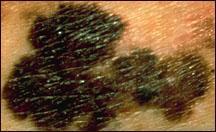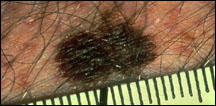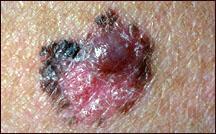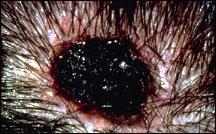Melanoma is a type of cancer that begins in melanocytes (cells that make the pigment melanin). Below are photos of melanoma that formed on the skin. Melanoma can also start in the eye, the intestines, or other areas of the body with pigmented tissues.
Often the first sign of melanoma is a change in the shape, color, size, or feel of an existing mole. However, melanoma may also appear as a new mole. People should tell their doctor if they notice any changes on the skin. The only way to diagnose melanoma is to remove tissue and check it for cancer cells.
Thinking of "ABCDE" can help you remember what to look for:
- Asymmetry: The shape of one half does not match the other half.
- Border that is irregular: The edges are often ragged, notched, or blurred in outline. The pigment may spread into the surrounding skin.
- Color that is uneven: Shades of black, brown, and tan may be present. Areas of white, gray, red, pink, or blue may also be seen.
- Diameter: There is a change in size, usually an increase. Melanomas can be tiny, but most are larger than the size of a pea (larger than 6 millimeters or about 1/4 inch).
- Evolving: The mole has changed over the past few weeks or months.
Melanomas can vary greatly in how they look. Many show all of the ABCDE features. However, some may show changes or abnormal areas in only one or two of the ABCDE features.
In more advanced melanoma, the texture of the mole may change. The skin on the surface may break down and look scraped. It may become hard or lumpy. The surface may ooze or bleed. Sometimes the melanoma is itchy, tender, or painful.
Photos of Melanoma


A large, asymmetrical melanoma with an uneven color and irregular border
A large, asymmetrical melanoma that is more than 10 millimeters (about 1/2 inch) wide


A melanoma with uneven color, an irregular border, and a scaly or flaky area
A melanoma with an irregular border

A melanoma with uneven color and an irregular border